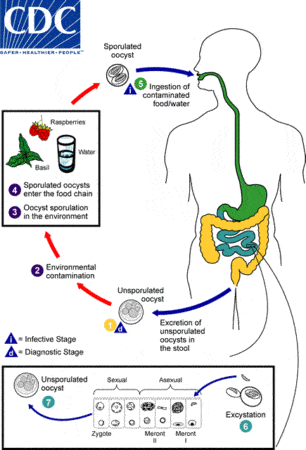Cyclospora Infections are up this Summer Sickening Nearly a 1,000 Persons in 36 States
The CDC Report
The CDC reported that since the beginning of 2017 to mid-September there have been 988 Laboratory confirmed cases of Cyclospora infected people in 36 states of the USA. The number of cases this year is significantly higher than in 2016.

The states with the most cases are Texas 28.8%, Florida 12.0%, and New York (including NYC) 10.6%.
Historical View
While the number of cases is higher this year, the director of CDC’s Division of Parasitic Disease, Dr. Monica Parise, said: “The numbers from this year were probably not outside the range that we’ve seen for the last five years,” According to Parise the numbers last year were low.

The CDC claims that it is not unusual to see an increase in Cyclospora infection in the US between May and September. However, as the table shows the increase this year seems to be outside the norm. In the last decade, only in 2005, the number of cases came close to this year, with 582 people sick in Florida. The outbreak source was identified as basil from Peru.
Reason for the Outbreak
Currently, no specific product has been connected to the infections, and it is unclear if the various cases in the different states are related to each other. The specific vehicles of the infections have not been identified and the sources are being investigated. The CDC report claims that “It is too early to say whether cases of Cyclospora infection in different states are related to each other or to the same food item(s).”
The EPI Curve
The EPI curve shows the progression of illnesses in an outbreak over time. It shows when people become ill by day. There is an inherent delay between the date that an illness starts and the date when the case is reported to public health authorities. For the Cyclospora outbreaks in 2 017, the following curve was generated by the CDC
017, the following curve was generated by the CDC
*N=553. Data are current as of 9/13/17. These cases occurred in persons with no history of travel outside of the United States or Canada in the 14 days before onset of illness. Illnesses that began after Aug. 2 may not yet have been reported to CDC because of the lag time between a victim’s first doctor visit, lab tests, paperwork and finally reports being filed with public health agencies.
Cyclosporiasis
Cyclosporiasis is an intestinal illness caused by the unicellular parasite Cyclospora cayetanensis. According to the CDC, People can become infected with Cyclospora by consuming food or water contaminated with the parasite.
The oocysts shed in the feces of infected persons must sporulate outside the host, to become infective for another person. Therefore, it is not transmitted usually from person to person, but through food or water. The sporulation process requires days to complete.
Cyclospora is by and large found in tropical and subtropical countries. It is normally not killed by most chemical disinfectants.
Products that historically caused outbreaks include fresh produce: basil, cilantro, lettuce, raspberries and snow peas.
Questions
Why do we see a higher number of infections despite FDA preventative measures?
Due to a number of outbreaks traced to fresh cilantro from the region of Pueblo, Mexico, the FDA increased inspection and enforcement there. According to the FDA “Beginning in 2015, from April 1 through August 31, cilantro from this region has been and continues to be detained without physical examination at the U.S.-Mexican border and refused admission into the United States.”
The FDA suggested in September 2016 that the lower number of infections that year correlated with the first full season that the FDA’s Import Alert for fresh cilantro from Puebla was in effect. Therefore, the question should be asked why we see such an increase this year.
